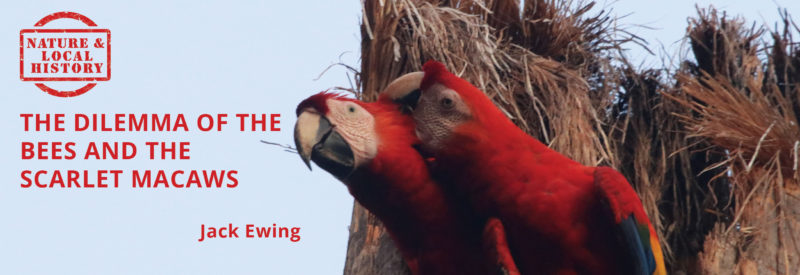What to Do When the “Most Important Living Being on the Planet” Becomes an Obstacle to the Return of a Charismatic, Locally Extinct Species?
Beginning in January of 2014 scarlet macaws began visiting Hacienda Barú and the surrounding area on a regular basis after having been locally extinct for 50 years. The macaws’ behavior suggested that they might be scouting out nesting sites. We decided to put up nesting boxes in four trees that the big red birds frequented and see if we could help them out. Many types of boxes are described on Internet, but we chose a wooden one measuring 35 cm x 35 cm x 70 cm. All were mounted about 20 meters above the ground. We waited for the macaws to move in, but that never happened. The boxes just hung there, empty, we thought.
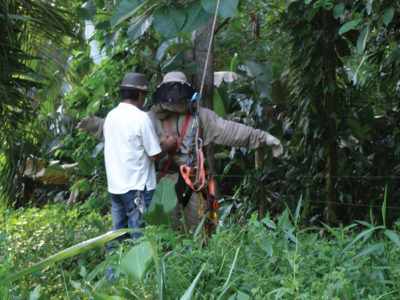 About a year later one of our guides thought he saw movement at the entrance hole to a nesting box and focused his spotting scope on it to see if anything was inside. What he saw astounded everyone. The box was full of bees. No wonder the macaws weren’t interested in nesting there, and even stopped visiting the trees. A quick check confirmed that all four boxes contained active hives of bees. We borrowed a protective bee suit from the Quepos fire department, climbed the trees, destroyed the hives, and lowered the boxes. With that many hives in such a small area they would all be competing for locations suitable for new hives and could be expected to invade any natural cavity in rainforest trees or logs. Though there needs to be more research before we can say with any certainty, it appears that the Africanised bees are out competing the macaws for nesting sites, and probably other bird species as well. They have even been known to attack and kill macaw chicks.
About a year later one of our guides thought he saw movement at the entrance hole to a nesting box and focused his spotting scope on it to see if anything was inside. What he saw astounded everyone. The box was full of bees. No wonder the macaws weren’t interested in nesting there, and even stopped visiting the trees. A quick check confirmed that all four boxes contained active hives of bees. We borrowed a protective bee suit from the Quepos fire department, climbed the trees, destroyed the hives, and lowered the boxes. With that many hives in such a small area they would all be competing for locations suitable for new hives and could be expected to invade any natural cavity in rainforest trees or logs. Though there needs to be more research before we can say with any certainty, it appears that the Africanised bees are out competing the macaws for nesting sites, and probably other bird species as well. They have even been known to attack and kill macaw chicks.
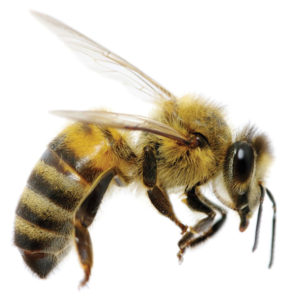 Our experience at Hacienda Barú with what biologists call “Africanized bees” began over 35 years ago. During the 1950’s some scientists in Brazil imported a number of hives from an extremely aggressive African species in the hopes of increasing honey production in Brazil. The problem began in 1957 when 26 swarms escaped into the wild. They cross bred with the much gentler local bees thus producing a hybrid. These started moving out in every direction. By the time they reached Costa Rica, in the mid-1980s, they were less aggressive than the original African species, but considerably more aggressive than our local honey bees. Africanized bees have a larger defensive area around the hive, react more quickly to any perceived threat, react in larger numbers, and chase the victim farther. They soon acquired the nickname “killer bees”, which seems fitting as over 1000 humans and many more farm animals in the Americas have been killed by them. Just last week some workers at Hacienda Barú were chased over 150 meters by angry Africanized bees that didn’t like the sound of the motorized weed cutter they were using.
Our experience at Hacienda Barú with what biologists call “Africanized bees” began over 35 years ago. During the 1950’s some scientists in Brazil imported a number of hives from an extremely aggressive African species in the hopes of increasing honey production in Brazil. The problem began in 1957 when 26 swarms escaped into the wild. They cross bred with the much gentler local bees thus producing a hybrid. These started moving out in every direction. By the time they reached Costa Rica, in the mid-1980s, they were less aggressive than the original African species, but considerably more aggressive than our local honey bees. Africanized bees have a larger defensive area around the hive, react more quickly to any perceived threat, react in larger numbers, and chase the victim farther. They soon acquired the nickname “killer bees”, which seems fitting as over 1000 humans and many more farm animals in the Americas have been killed by them. Just last week some workers at Hacienda Barú were chased over 150 meters by angry Africanized bees that didn’t like the sound of the motorized weed cutter they were using.
The US Department of Agriculture was concerned that the Africanized bees would migrate as far as the United States. They decided to try and stop them in Costa Rica, the narrowest point in the Central American isthmus. They trained a group Costa Rican Ministry of Agriculture (MAG) employees as well as the fire departments to combat them and provided the necessary resources for salaries, vehicles, and equipment. For a couple of months in 1984 MAG employees as well as USDA personnel were a common sight. They destroyed several hives on Hacienda Barú. One day the USDA received the message that the bees had been reported in El Salvador. Not much later they appeared in the San Joaquin Valley in southern California. In Costa Rica the Africanized bees have taken over completely. There are no more of the original local honey bees left here. The Africanised bees have been called the most successful biologically invasive species ever to plague the western hemisphere.
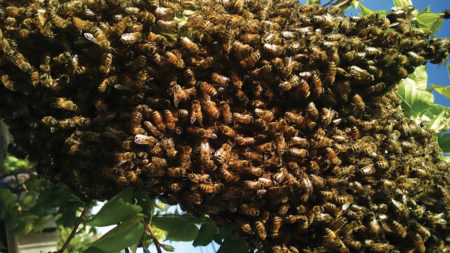 So what is the dilemma? These bees are not native to Costa Rica. They are interfering with the natural nesting activity of the macaws. Just kill the bees in any way you can. But then things became more complicated.
So what is the dilemma? These bees are not native to Costa Rica. They are interfering with the natural nesting activity of the macaws. Just kill the bees in any way you can. But then things became more complicated.
You may have heard that bees have been declared the most important living being on the planet. I have seen this news item at least five times on Facebook in the last month. I agree that bees are very important pollinators, but it would be difficult to declare any one class of living things the most important. There were several different postings with differing headlines like: “Royal Geographic Soceity of London Declares That Bees Are the Most Important Living Being on the Planet”, “World Watch Declares at Royal Geographic Society…..etc”, and “Scientists Declare That Bees…..etc”. All of the articles were vague about who actually made this declaration. All insinuated that it had been fairly recent. They mainly focused on how important bees are and the horrible consequences to humanity if they were to become extinct. If bees are really the most important living being on Earth, maybe we shouldn’t kill them even if they are interfering with the macaws nesting. But something just didn’t sound right. My curiosity and skeptical nature got the best of me, and I started digging. Finally I got right to the nitty gritty, an article in a British newspaper, The Guardian, from 2008. Apparently, every year the Worldwatch Institute holds a debate at a meeting of the Royal Geographic Society, both highly prestigious organizations. At the 2008 event five scientists debated over which was the most important living being on Earth: bats, bees, fungi, plankton, or primates. After the debate the audience voted, and bees came out the winner. What that really means is that the scientist who presented the case for bees was the best debater.
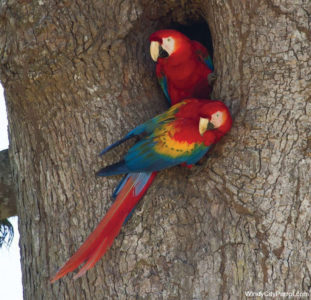 I agree that bees are very important to the well-being of the Planet. Nevertheless, there are around 25,000 species of bees in the world. The one that is plaguing the scarlet macaws is a rogue hybrid that is a danger to animals and humans. In my opinion we are just beginning to learn how damaging they have become to our tropical rainforest ecosystem. I feel certain that more information will come to light in the future, and that it won’t be good.
I agree that bees are very important to the well-being of the Planet. Nevertheless, there are around 25,000 species of bees in the world. The one that is plaguing the scarlet macaws is a rogue hybrid that is a danger to animals and humans. In my opinion we are just beginning to learn how damaging they have become to our tropical rainforest ecosystem. I feel certain that more information will come to light in the future, and that it won’t be good.
For me there is no dilemma. Kill the Africanised bees wherever you find them.
Jack Ewing was born and educated in Colorado. In 1970 he and his wife Diane moved to the jungles of Costa Rica where they raised two children, Natalie and Chris. A newfound fascination with the rainforest was responsible for his transformation from cattle rancher into environmentalist and naturalist. His many years of living in the rainforest have rendered a multitude of personal experiences, many of which are recounted in his published collection of essays, Monkeys are Made of Chocolate. His latest book is, Where Jaguars & Tapirs Once Roamed: Ever-evolving Costa Rica. Jack and Diane live on and manage the Hacienda Barú National Wildlife Refuge, a well-known ecotourism destination on the southwest coast of Costa Rica.

